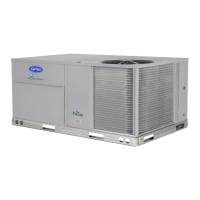102
Table 73 — Humidi-MiZer Service Analysis (cont)
Transducer Troubleshooting — The electronic con-
trol uses 2 suction and 2 discharge pressure transducers to mea-
sure the suction pressure of circuits A and B. The pressure/volt-
age characteristics of these transducers are in shown in
Table 81 and 82. The accuracy of these transducers can be ver-
ified by connecting an accurate pressure gage to the second re-
frigerant port in the suction line.
Forcing Inputs and Outputs — Many of variables
may be forced both from the CCN and directly at the local dis-
play. This can be useful during diagnostic testing and also dur-
ing operation, typically as part of an advanced third party
control scheme. See Appendix A and B.
NOTE: In the case of a power reset, any force levels in effect
at the time of the power reset will be cleared.
CONTROL LEVEL FORCING — If any of the following
points are forced with a priority level of 7 (consult CCN litera-
ture for a description of priority levels), the software clears the
force from the point if it has not been written to or forced again
within the timeout periods defined below:
Run Status Menu — The Run Status menu provides the
user important information about the unit. The Run Status table
can be used to troubleshoot problems and to help determine
how and why the unit is operating.
AUTO VIEW OF RUN STATUS — The Auto View of Run
Status display table provides the most important unit informa-
tion. The HVAC Mode (Run Status
VIEW
HVAC) in-
forms the user what HVAC mode the unit is currently in. Refer
to the Modes section on page 41 for information on HVAC
modes. The occupied status, unit temperatures, unit set points,
and stage information can also be shown. See Table 83.
Run Status
VIEW
HVAC — Displays the current HVAC
Mode(s) by name. HVAC Modes include:
OFF VENT HIGH HEAT
STARTING UP HIGH COOL FIRE SHUT DOWN
SHUTTING DOWN LOW COOL PRESSURIZATION
DISABLED UNOCC FREE COOL EVACUATION
SOFTSTOP REQUEST TEMPERING HICOOL SMOKE PURGE
REM SW DISABLE TEMPERING LOCOOL DEHUMIDIFICATION
COMP STUCK ON TEMPERING VENT RE-HEAT
TEST LOW HEAT
Run Status
VIEW
OCC — Displays the current occupan-
cy status of the control.
Run Status
VIEW
MAT — Displays the current value for
mixed-air temperature. This value is calculated based on
return-air and outside-air temperatures and economizer damper
position.
PROBLEM CAUSE REMEDY
Unit Initiates a Humidi-MiZer
Dehumidification Mode, but
Supply Air Temperature is
Overheating/Overcooling the
Space
Supply air set point for cooling is too
high/low
Check the unit supply air set point for cooling operation. This is the
temperature that the valves will modulate to meet during a dehu-
midification mode.
Evaporator discharge temperature
(CCT) or supply air temperature (SAT)
thermistor is reading incorrectly.
See "Thermistor Troubleshooting" on page 99
Check if SAT thermistor is in a location that is measuring stratified
air
Valve controlling gas bypass around
the condenser is not functioning
properly
See "Modulating Valves Not Functioning Properly"
Valve controlling refrigerant flow to the
condenser is not functioning properly
See "Modulating Valves Not Functioning Properly"
Modulating valves are not calibrated
properly
See "Modulating Valves Not Functioning Properly"
Unit control software indicates a
Humidi-MiZer Reheat Mode, but the
3-way valve is not functioning properly
See "3-Way Valve Malfunction"
Unit is not sized to meet the load at the
current entering air and outdoor
conditions.
Check product data tables or ECAT for rated capacity at current
entering air and outdoor conditions.
Low Sensible Capacity in
Normal Cooling Mode
Valve controlling gas bypass around
the condenser is stuck in an open posi-
tion or leaking
See "Modulating Valves Not Functioning Properly"
Valve controlling refrigerant flow to the
condenser is stuck in a position less
than 100% open
See "Modulating Valves Not Functioning Properly"
General cooling mode problem See Table 72.
Modulating Valves Not
Functioning Properly
Faulty wire connections Check that the valve wiring is properly connected from the valve,
entering the control box and at the EXV board
EXV board malfunction Check alarm history for A169 (Expansion Valve Control Board
Comm Failure)
Valve is stuck open/closed Use Service Test to manually manipulate the valve position and
confirm supply air temperature changes during operation.
Run valve calibration through Service Test
Check valve motor for open or short circuited windings. Shut down
power to the unit and connect ohmmeter probes across the black
and white terminals. Resistance should measure 75 ohms ±10%.
Next, connect ohmmeter probes across the red and green termi-
nals. Resistance should measure 75 ohms ±10%. The meter
should not show an "open" or a "short" when a winding leg is mea-
sured. If either occurs, replace the valve.
Valve is not calibrated properly Run valve calibration through Service Test
Temperatures
AIR.T
OAT Outside Air Temperature 30 minutes
Temperatures
AIR.T
RAT Return Air Temperature 3 minutes
Temperatures
AIR.T
SPT Space Temperature 3 minutes
Inputs
RSET
SP.RS Static Pressure Reset 30 minutes
Inputs
REL.H
OA.RH Outside Air Relative Humidity 30 minutes
Inputs
AIR.Q
OAQ Outside Air Quality 30 minutes

